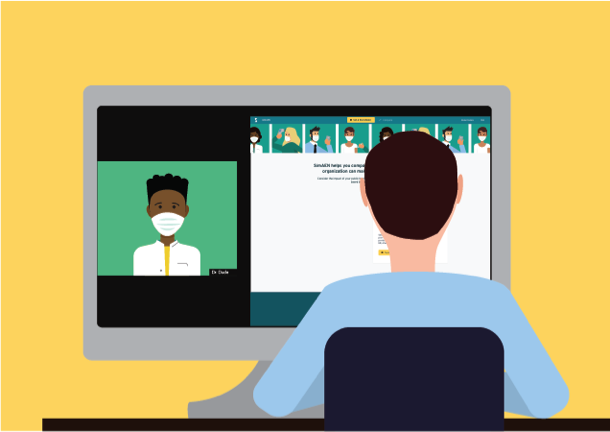COVID-19 exposure simulation technology is transferred to the CDC
Lincoln Laboratory recently transferred its Simulated Automatic Exposure Notification (SimAEN) technology to the Centers for Disease Control and Prevention (CDC). The CDC funded the project to address a growing need to model the effects of COVID-19 mitigation strategies.
SimAEN simulates the potential spread of COVID-19 by modeling the behavior of individual agents, which represent people. The tool is unique in that it simulates small segments of the population and makes informed assumptions about their behavior. This design makes SimAEN lightweight and easy to run compared to other tools that try to simulate much larger groups and more specific behaviors.
"SimAEN demonstrates the effects of independent decision making by individual agents, much in the same way that people making decisions about things like getting tested, wearing masks, and getting vaccinated affect the overall effectiveness of stopping the spread of COVID-19," says William Streilein, a principal staff member in the Biotechnology and Human Systems Division. "It enables public health teams to focus on the factors they have more control over, like messaging and obtaining resources."

"Each agent has the same choices that people in real life have," says Dieter Schuldt, a researcher in the Humanitarian Assistance and Disaster Relief Systems Group. "Each simulated day, they make these decisions and interact with other agents and environments."
The impact these choices have on the simulation is based on research into how these choices can increase or decrease the spread of COVID-19. Because new research is available often, these variables can be adjusted easily in SimAEN. The simulations help public health officials make informed decisions, such as whether to commit resources to manual contact tracing or to adjust the configurations of automated exposure notifications sent to people's Android and iOS devices to be more or less sensitive. This notification technology has its roots in MIT and Lincoln Laboratory, and is now deployed in many states.
"The SimAEN model implementation enables public health teams to explore the parameters of community response to COVID-19, including vaccination rates, masking, and compliance with quarantine and isolation recommendations," says Curran Schiefelbein of the Homeland Protection Systems Group. "The web interface provides a lightweight way for these teams to observe and consider the predicted effects of different parameter combinations."
Now that the project has been transferred to the CDC, the CDC is publicly hosting the code for SimAEN on GitHub, which allows other developers to submit potential improvements to SimAEN or adapt it for their own needs. The CDC also now hosts a website for SimAEN.
SimAEN was developed in response to COVID-19 but also has potential for simulating the spread of other diseases such as the flu, Ebola, or measles, since it does not make any assumptions about how a disease is specifically transmitted. SimAEN can also be adapted for variants of COVID-19.
"We anticipate that SimAEN will be straightforward to adapt and refine as new information becomes available," says Schiefelbein. "The CDC’s Informatics Innovation Unit is ready to receive feedback and potential improvements as other researchers weigh in, and we are eager to see what comes of it."